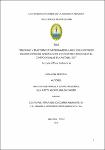| dc.contributor.advisor | Pérez Marcovich, Graciela Mercedes | |
| dc.contributor.advisor | Sologuren Anchante, Rafael Fernando | |
| dc.contributor.author | Benites Meléndez, Denisse Fiorella | |
| dc.contributor.author | Malca Cavero, Katty Andrea | |
| dc.date.accessioned | 2018-01-29T15:10:16Z | |
| dc.date.available | 2018-01-29T15:10:16Z | |
| dc.date.issued | 2017 | |
| dc.identifier.uri | http://repositorio.unapiquitos.edu.pe/handle/20.500.12737/5261 | |
| dc.description.abstract | El propósito de la presente investigación fue Determinar la relación entre Bruxismo y
Trastornos Temporomandibulares según el índice Criterios de Diagnóstico de Investigación (CDI) en pacientes atendidos en el Centro de Salud San Antonio, 2017.El tipo de investigación fue cuantitativa, el diseño fue no experimental, correlacional, transversal. La muestra estuvo conformada por 353 pacientes atendidos en el consultorio odontológico del Centro de Salud San Antonio en una población de 1088 pacientes del Centro de Salud San Antonio. Se utilizó el instrumento de Diagnóstico de Bruxismo de Diaz y cols. Y el instrumento de Criterios de Diagnóstico de Investigación (CDI) para Trastornos Temporomandibulares.
Los resultados más importantes fueron: Sí existe una relación entre Bruxismo y rastornos
Temporomandibulares. La prevalencia de TTM fue de 35.7%. La prevalencia de Click fue
de 0.6%. El 0.6% reportó crepitación a la apertura o cierre. El 0.6 % de pacientes reportaron bloqueo articular. La prevalencia de bruxofacetas fue de 39.9 %. La prevalencia de Hipertrofia muscular fue de 9.6 %. El 92.1% no reportó movilidad dentaria. La prevalencia de Bruxismo fue 26,3%. Los pacientes con Bruxismo presentaron el mayor porcentaje de diagnósticos de TTM. DDSRAL (Desplazamiento de Disco sin Reducción con Apertura Limitada) y Bruxismo fue de 2,2%; EDA(Enfermedad Degenerativa Articular) f y Bruxismo fue de 2,2%; dolor muscular fue de 68,8% y dolor articular fue de 15.1%. El 64.3% no presentó ningún tipo de diagnóstico, el 29.5% presentó dolor muscular con prevalencia en el género femenino, el 5.1% presentó dolor articular con prevalencia en género femenino, el 0.6% presentó DDSRAL con prevalencia en género femenino, el 0.6% presentó EDA con prevalencia en género femenino. En el DDSRAL se reportó una prevalencia en el grupo etario de 41-50 años, en el diagnóstico de EDA se reportó una prevalencia en el grupo etario de 61-70 años, en el Dolor Muscular se presentó mayor prevalencia en el grupo etario hasta los 20 años, en el Dolor Articular se presentó mayor prevalencia en el grupo etario desde los 18 hasta los 30 años. | es_PE |
| dc.description.abstract | The purpose of the present investigation was to determine the relationship between bruxism and temporomandibular disorders according to the Diagnostic Criteria for Research (CDI) index in patients attended at the San Antonio Health Center, 2017. The type of research was quantitative, the design was not experimental, correlational, transverse. The sample consisted of 353 patients attended at the dental office of the San Antonio Health Center in a population of 1088 patients of the San Antonio Health Center. The instrument of Diagnosis of Bruxism of Diaz et al. And the instrument of Diagnostic Research Criteria (ICD) for Temporomandibular Disorders. The most important results were: There is a relationship between Bruxism and Temporomandibular Disorders. The prevalence of TMD was 35.7%. The prevalence of Click was 0.6%. 0.6% reported crepitus at opening or closing. 0.6% of patients reported joint block. The prevalence of bruxofacetas was 39.9%. The prevalence of muscle hypertrophy was 9.6%. 92.1% did not report dental mobility. The prevalence of bruxism was 26.3%.
Patients with bruxism had the highest percentage of TTM diagnoses. DDSRAL (Disc
Displacement without Reduction with Limited Aperture) was 2.2%; EDA (Articular
Degenerative Disease) was 2.2%; muscle pain was 68.8% and joint pain was 15.1%. 64.3% did not present any type of diagnosis, 29.5% presented muscle pain with prevalence in the female gender, 5.1% presented joint pain with prevalence in female gender, 0.6% presented DDSRAL with prevalence in female gender, 0.6% presented EDA with prevalence in female gender. In the DDSRAL a prevalence was reported in the age group of 41-50 years, in the diagnosis of EDA a prevalence was reported in the age group of 61-70 years, in the Muscular Pain there was a higher prevalence in the age group until the 20 years, in Joint Pain there was a higher prevalence in the age group from 18 to 30 years. | en_US |
| dc.description.uri | Tesis | es_PE |
| dc.format | application/pdf | es_PE |
| dc.language.iso | spa | es_PE |
| dc.publisher | Universidad de la Amazonía Peruana | es_PE |
| dc.rights | info:eu-repo/semantics/openAccess | es_PE |
| dc.rights | Attribution-NonCommercial-NoDerivs 3.0 United States | * |
| dc.rights.uri | http://creativecommons.org/licenses/by-nc-nd/3.0/us/ | * |
| dc.source | Universidad Nacional de la Amazonía Peruana | es_PE |
| dc.source | Repositorio institucional - UNAP | es_PE |
| dc.subject | Bruxismo | es_PE |
| dc.subject | Enfermedades mandibulares | es_PE |
| dc.subject | Diagnóstico | es_PE |
| dc.title | Bruxismo y trastornos temporomandibulares según criterios de diagnóstico de investigación en pacientes atendidos en el Centro de salud San Antonio, 2017 | es_PE |
| dc.type | info:eu-repo/semantics/bachelorThesis | es_PE |
| thesis.degree.discipline | Odontología | es_PE |
| thesis.degree.grantor | Universidad Nacional de la Amazonía Peruana. Facultad de Odontología | es_PE |
| thesis.degree.level | Título Profesional | es_PE |
| thesis.degree.name | Cirujano Dentista | es_PE |
| thesis.degree.program | Regular | es_PE |
| dc.subject.ocde | http://purl.org/pe-repo/ocde/ford#3.02.14 | es_PE |


